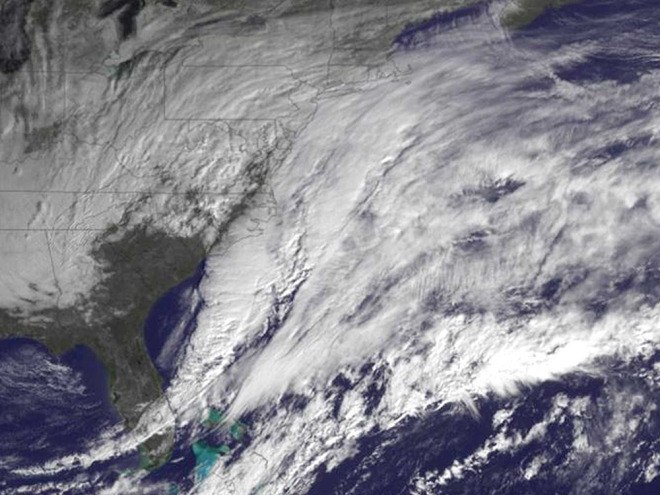
Here’s How We Know Global Warming Made the Blizzard Worse
Manhattan may have gotten the wimpy end of Juno, but the storm chin-checked New England. Boston is buried in snow. Hurricane-force winds buffeted Nantucket. The storm surge may have permanently altered shorelines from New Haven, Connecticut, to Portland, Maine1. Storms have always happened in winter, but the excessively violent ones? They’re getting more common, and that’s due to climate change.
“It’s winter, and we have storms, so that part is entirely natural,” says Kevin Trenberth, a senior scientist at the National Center for Atmospheric Research, the federal government’s center for understanding weather and climate. “The global warming aspect relates to the fact that the oceans are warmer, and the air above them is more moist.”
Trenberth’s expertise puts him in the potentially uncomfortable position of trying to use scientific data to answer what has become a politicized question. But he says that doesn’t bother him because the numbers speak for themselves. Climate models—heavy-lifting computation that simulates the fluid dynamics of the whole planet—show that oceans are like batteries, charging up with extra warmth as atmospheric carbon continues to warm the planet. But that energy storage isn’t free. What goes in must come out, feeding bigger, badder storms. In the case of Winter Storm Juno, extra warmth in the ocean possibly lowered air pressure by a few bars. That means more wind and bigger storm surges.
Right now, the oceans are overclocked. “Over 90 percent of the energy currently in the ocean is caused by climate change,” Trenberth says. Scientists know this through temperature measurements combined with observations of minuscule rises in sea level. They can attribute only about half of current sea level rise—a rate of more than a tenth of an inch annually between 1993 and 2010—to the volume of water that has melted from the world’s glaciers. The rest is due to thermal energy: Warmer water occupies more space.
That’s almost certainly what happened with Hurricane Sandy. After that storm, scientists at the European Center for Medium-Range Weather Forecasts gathered data on wind speed, precipitation, and other relevant factors and calculated the storm’s total energy level. Then they ran the storm through a range of modeled warming scenarios. After hundreds of iterations, they found the pressure in Sandy’s eye would have been eight millibars higher if the oceans had been the same temperature as they were in the 1970s. That might not sound like much, but it’s enough that Trenberth says at 1970s levels the subways probably wouldn’t have flooded. Warmer oceans also mean higher humidity—moisture in the air—and that translates into more snow. “Storms typically reach out about five times beyond the diameter of their clouds to grab available moisture,” Trenberth says. In other words, if a storm has a 500-mile footprint, you can expect that the moisture is being pulled from a 2,500-mile area. The more water vapor in that footprint, the more snow piling up on New England driveways.
No one will know if Juno will show the same numbers until the storm is over. Noah Diffenbaugh, a climate scientist at Stanford University, agrees that Juno is feeding on the ocean’s surplus of carbon-related energy. But he and his colleagues don’t have numbers to run just yet. When they do, Diffenbaugh says they’ll follow the standard procedure of including a no-climate-change scenario as one of the possibilities—“assuming no effect of global warming,” as Diffenbaugh puts it.
Unsurprisingly, Trenberth is a favorite whipping boy for climate skeptics. (The comments on this story will no doubt bear this out.) But he hasn’t flinched from espousing the facts from his research: Climate change is real, it’s caused by our appetite for carbon-based energy, and from now on, it’ll be a part of every weather-related event.
Manhattan may have gotten the wimpy end of Juno, but the storm chin-checked New England. Boston is buried in snow. Hurricane-force winds buffeted Nantucket. The storm surge may have permanently altered shorelines from New Haven, Connecticut, to Portland, Maine1. Storms have always happened in winter, but the excessively violent ones? They’re getting more common, and that’s due to climate change.
“It’s winter, and we have storms, so that part is entirely natural,” says Kevin Trenberth, a senior scientist at the National Center for Atmospheric Research, the federal government’s center for understanding weather and climate. “The global warming aspect relates to the fact that the oceans are warmer, and the air above them is more moist.”
Trenberth’s expertise puts him in the potentially uncomfortable position of trying to use scientific data to answer what has become a politicized question. But he says that doesn’t bother him because the numbers speak for themselves. Climate models—heavy-lifting computation that simulates the fluid dynamics of the whole planet—show that oceans are like batteries, charging up with extra warmth as atmospheric carbon continues to warm the planet. But that energy storage isn’t free. What goes in must come out, feeding bigger, badder storms. In the case of Winter Storm Juno, extra warmth in the ocean possibly lowered air pressure by a few bars. That means more wind and bigger storm surges.
Right now, the oceans are overclocked. “Over 90 percent of the energy currently in the ocean is caused by climate change,” Trenberth says. Scientists know this through temperature measurements combined with observations of minuscule rises in sea level. They can attribute only about half of current sea level rise—a rate of more than a tenth of an inch annually between 1993 and 2010—to the volume of water that has melted from the world’s glaciers. The rest is due to thermal energy: Warmer water occupies more space.
That’s almost certainly what happened with Hurricane Sandy. After that storm, scientists at the European Center for Medium-Range Weather Forecasts gathered data on wind speed, precipitation, and other relevant factors and calculated the storm’s total energy level. Then they ran the storm through a range of modeled warming scenarios. After hundreds of iterations, they found the pressure in Sandy’s eye would have been eight millibars higher if the oceans had been the same temperature as they were in the 1970s. That might not sound like much, but it’s enough that Trenberth says at 1970s levels the subways probably wouldn’t have flooded. Warmer oceans also mean higher humidity—moisture in the air—and that translates into more snow. “Storms typically reach out about five times beyond the diameter of their clouds to grab available moisture,” Trenberth says. In other words, if a storm has a 500-mile footprint, you can expect that the moisture is being pulled from a 2,500-mile area. The more water vapor in that footprint, the more snow piling up on New England driveways.
No one will know if Juno will show the same numbers until the storm is over. Noah Diffenbaugh, a climate scientist at Stanford University, agrees that Juno is feeding on the ocean’s surplus of carbon-related energy. But he and his colleagues don’t have numbers to run just yet. When they do, Diffenbaugh says they’ll follow the standard procedure of including a no-climate-change scenario as one of the possibilities—“assuming no effect of global warming,” as Diffenbaugh puts it.
Unsurprisingly, Trenberth is a favorite whipping boy for climate skeptics. (The comments on this story will no doubt bear this out.) But he hasn’t flinched from espousing the facts from his research: Climate change is real, it’s caused by our appetite for carbon-based energy, and from now on, it’ll be a part of every weather-related event.





Следующая запись: J.Flex – гибкая батарея для одежды и нестандартных устройств
Лучшие публикации